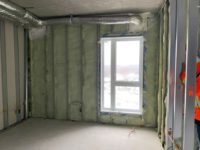Insulation is No Longer Just Insulation




High-performance building envelopes are designed and constructed to be particularly well adept at acting as an environmental separator, keeping the influence of outdoor elements from infiltrating and impacting the encapsulated indoor environment. A well-designed enclosure must not only insulate, but must control moisture, air temperature and vapor. Because of the number of variables that an envelope must address, more often than not they have been designed as complex layered structures, with numerous products combined to comprise the total system.
Continuous insulation is one such layer, which is installed on the outside of the structure. The structure’s total thermal performance is optimized when this outer insulation layer is augmented with additional insulation installed in the stud cavity. In this manner, the insulation solution is likened to a coat (outer continuous insulation layer) and a sweater (insulation in stud cavity) working together.
Typically, insulation acts primarily as the thermal control layer with other products serving as the air, vapor and moisture control layers. Due to its need to handle all these additional elements, it’s not surprising that a higher performing enclosure has traditionally included a plethora of products to achieve all functions.
However, the introduction of new materials, as well as the drive toward product innovation, have each delivered numerous improved envelope solutions. But no matter how great product innovation is for the industry and the end user, it makes the specification of products for the enclosure difficult. An architect or specifier’s product knowledge base is essentially a continuous, challenging learning curve. Not only must they keep abreast of new solutions, but of how different materials interact and impact the system.
The Trend Toward Multi-Use Envelope Products
When selecting products, architects and specifiers are looking for solutions to create a better envelope. Energy efficiency, durability, resiliency and a healthier indoor environment are all key goals of the optimized enclosure. But a growing trend is the reduction in the number of products specified to accomplish these goals. Many newer materials now combine key functions and benefits, allowing those creating structures to specify less products overall.
For years now, a common product utilized to combine air and water control layers into one “jacket” has been building wraps and these have provided a baseline of performance. However, the many penetrations required to nail the wrap into place undermine the product’s air and water barrier performance. Likewise, self-adhered membranes and liquid-applied barriers don’t require penetrations during installation, and advancements have allowed them to perform as water, air and vapor control in one layer. Yet these products still don’t have a thermal control element, so they require an additional layer for that purpose.
Another envelope option—rigid foam plastic insulation boards—achieves water, air and vapor control in a single thick layer. However, rigid insulation boards have some drawbacks. They require significant time and additional materials (e.g. screws and washers) for installation, while curved or oddly shaped buildings increase installation complexity and time onsite to fit the boards. Penetrations ranging from brick ties and piping/conduits to windows further increase the challenge of maintaining unbroken water and air barriers. Moreover, rigid foam boards have a lot of joints, which may be sealed at the time of construction but become unsealed over time, allowing air or water leakage into the structure.
One high-performance alternative to rigid foam boards is medium-density, closed-cell spray foam (SPF) insulation, which performs remarkably well as a single-source solution for thermal, air, vapor and water control. As a thermal insulator, SPF boasts one of the highest R-values per inch of all insulation options available. Because the material forms in-place and fully adheres, it virtually eliminates cracks and gaps that leak air or water. It can also be applied in a continuous layer, eliminating most thermal bypasses. The superior thermal performance and air-sealing from SPF lowers energy costs for the building over the lifespan of the product. Closed-cell SPF also provides structural enhancement and qualifies as both a vapor retarder and secondary water barrier.
These closed cell SPF insulation capabilities protect the structure against mold and water damage, maintain indoor temperatures and reduce energy costs. They also improve indoor air quality, dramatically minimizing the volume of allergens and pollutants able to enter the structure. Combined, these qualities result in a high-performance envelope, creating greater indoor comfort and dramatically reducing long-term heating and cooling demands.
Regardless of what materials and combined solutions are selected for a high-performance envelope, the trend will likely continue toward the specification of less products, especially if those selected can perform more of the key barrier functions: thermal, air, water and moisture.
Looking for a reprint of this article?
From high-res PDFs to custom plaques, order your copy today!








